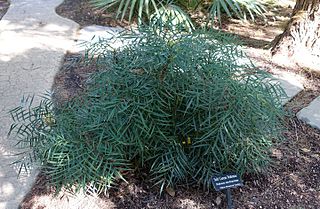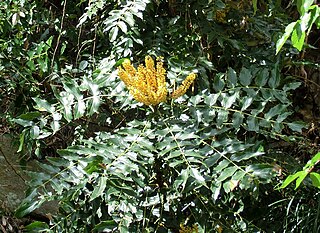
Mahonia is a formerly accepted genus of approximately 70 species of shrubs or, rarely, small trees with evergreen leaves in the family Berberidaceae, native to eastern Asia, the Himalaya, North America, and Central America. They are closely related to the genus Berberis and as of 2023 the majority of botanical sources list it as a synonym for Berberis.

Berberis, commonly known as barberry, is a large genus of deciduous and evergreen shrubs from 1–5 m (3.3–16.4 ft) tall, found throughout temperate and subtropical regions of the world. Species diversity is greatest in South America and Asia; Europe, Africa and North America have native species as well. The best-known Berberis species is the European barberry, Berberis vulgaris, which is common in Europe, North Africa, the Middle East, and central Asia, and has been widely introduced in North America. Many of the species have spines on the shoots and all along the margins of the leaves.
Berberis decipiens is a species of shrub in the Berberidaceae described as a species in 1913. It is endemic to Hubei Province in China. The species is listed as vulnerable by the IUCN.

Berberis japonica is a species of flowering plant in the family Berberidaceae, native to Taiwan. Despite the name, it is not native to Japan, though it has been known in cultivation there for centuries. The wild origins of this species have long puzzled botanists, but wild plants in Taiwan, previously known under the name Mahonia tikushiensis, appear most similar to the cultivated forms of B. japonica.
Berberis × hortensis is an interspecific hybrid shrub. Its parents are Berberis oiwakensis and Berberis japonica. It was raised in gardens during the 20th century, and has become an important garden and landscape plant.

Berberis fortunei is a species of shrubs in the family Berberidaceae, the barberry family, described as a species in 1846. It is endemic to China, found in the provinces of Chongqing, Guangxi, Guizhou, Hubei, Hunan, Jiangxi, Sichuan, Taiwan, and Zhejiang. It is grown as an ornamental in many lands, with common names including Chinese mahonia, Fortune's mahonia, and holly grape.

Berberis bealei, also known as leatherleaf mahonia, Beale's barberry, or Oregon grape, is a species of evergreen shrub native to mainland China. The species has been regarded as the same species as Berberis japonica, native to Taiwan, but the two differ consistently in certain floral and leaf characters. Both species are widely cultivated in many countries as ornamentals. Berberis bealei has reportedly escaped cultivation and become established in the wild in scattered places in the south-eastern United States from Arkansas to Florida to Delaware.
Berberis bracteolata is a shrub in the Berberidaceae described as a species in 1917. It is endemic to China, known from Sichuan and Yunnan Provinces.
Berberis breviracema is a shrub in the Berberidaceae described as a species in 1985. It is endemic to China, native to Guangxi and probably Guizhou Provinces.

Berberis eurybracteata is a species of shrub in the Berberidaceae described as a species in 1901. It is endemic to China.
Berberis fordii is a species of shrub in the Berberidaceae described as a species in 1913. It is endemic to China, found in Chongqing and Guangdong Provinces.

Berberis gracilipes is a shrub in the family Berberidaceae, first described in 1887. It is endemic to China, native to the Sichuan and Yunnan Provinces.
Berberis hancockiana is a species of flowering plant in the family Berberidaceae, first described in 1917. It is endemic to Yunnan Province in southwestern China.
Berberis leptodonta is a shrub in the family Berberidaceae, first described in 1938. It is endemic to China, found in Sichuan and Yunnan Provinces.
Berberis longibracteata is a shrub in the family Berberidaceae, first described as a species in 1917. It is endemic to China, found in Sichuan and Yunnan Provinces.
Berberis monyulensis is a shrub in the family Berberidaceae first described as a species in 1961. It is endemic to Tibet.

Berberis napaulensis Nepali: जमाने मान्द्रो is a shrub in the family Berberidaceae described as a species in 1821. It is native to China and the Himalayas. This species is used medicinally throughout the Sikkim Eastern Himalayas.
Berberis schochii is a shrub in the Berberidaceae described as a species in 1913. It is endemic to China, known from the provinces of Guizhou and Sichuan.
Berberis paucijuga is a shrub in the family Berberidaceae described as a species in 1987. It is endemic to the province of Yunnan in southwestern China.
Berberis polyodonta is a shrub in the Berberidaceae described as a species in 1901. It is native to Assam, Myanmar, and southwestern China.










